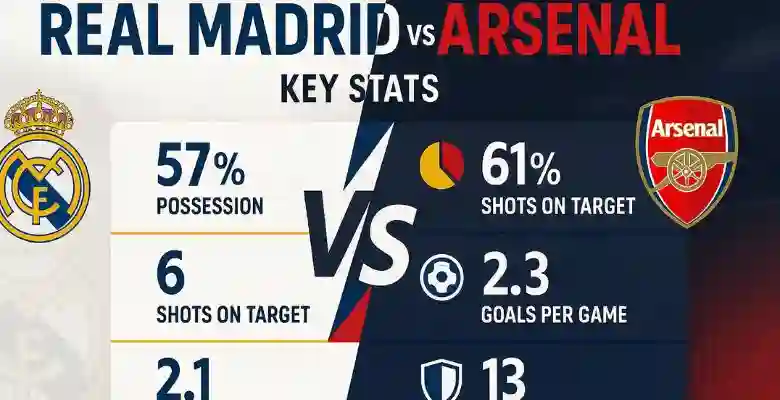
Real Madrid vs Arsenal F.C. Stats
When you think of the inter-European clash between Real Madrid and Arsenal F.C., you picture a classic battle—Madrid’s vast continental pedigree against Arsenal’s rebuilding ambition. When we analyse the real madrid vs arsenal f.c. stats, however, the story is not just about numbers on the page—it’s about momentum, psychology, tactics and the shifting of a footballing paradigm.
Setting the Scene
Historical Context
In previous meetings, Real Madrid held an aura of invincibility. Yet the head-to-head reveals something striking: in four recorded competitive fixtures, Arsenal have three wins, one draw and Real Madrid none. That in itself is a starting point to the deeper grammar of their clash.
This statistic alone invites us to ask: what changed? How did Arsenal turn the tables on a club that, by reputation, should dominate?
The 2024-25 Quarter-Finals — Data Snapshot
The 2024-25 UEFA Champions League quarter-finals provided the richest recent ground for examining the real madrid vs arsenal f.c. stats.
-
First leg (Arsenal 3-0 Real Madrid): Arsenal’s free-kick specialist Declan Rice opened the scoring with a curling strike in the 58th minute, repeated in the 70th, and Mikel Merino added a third at 75′.
-
Second leg (Real Madrid 1-2 Arsenal): At the Santiago Bernabéu, Arsenal claimed a 2-1 win, completing a 5-1 aggregate.
-
Match statistics: In the second leg, Real Madrid had 66.2% possession yet only three shots on goal to Arsenal’s six.
-
Broader set: Across the fixture, Arsenal minimized Real Madrid’s strengths and maximized their own. In head-to-head totals Real Madrid scored 1 goal; Arsenal scored 6 across their meetings.
These numbers – possession, shots, goal margins, historical trends – all feed into the narrative of how Arsenal executed a strategic shock.
Dissecting the Stats
Possession vs Impact
The real madrid vs arsenal f.c. stats show Real Madrid dominated possession in the second leg yet failed to turn that dominance into meaningful attacking output. 66.2% possession for Madrid (vs 33.8% for Arsenal) with fewer shots on goal (3 vs 6). What does this tell us? Possession is not the full story. Arsenal’s discipline, pressing and quick transitions meant that less time on the ball did not equal less threat. When Arsenal did have the ball, they were sharper.
Efficiency and Shot Quality
Arsenal’s two free-kick goals, and minimal chances conceded, highlight their efficiency. Real Madrid’s shot attempts were numerous in the aggregate, but lacked the precision and structural penetration that their coaches expect.
In the first leg, Arsenal had 12 total shots, Real Madrid 9; Arsenal’s clear-cut chances and passing accuracy were superior.
Here the real madrid vs arsenal f.c. stats show a contrast: ball control versus quality of control, fragmentation versus coherence.
H3: Head-to-Head Trends
Looking at the broader record between the clubs: Real Madrid 0 wins, Arsenal 3 wins, 1 draw. Goals scored: Real Madrid 1, Arsenal 6.
That kind of dominance – by a relative outsider versus a traditional giant – signals more than a fluke. It indicates a shift in dynamics. Arsenal’s game-model under Mikel Arteta shows speed, organization and defensive solidity that exploited Real Madrid’s moment of transition.
Key Insights & Storytelling
The Psychology of Underdog Success
Arsenal entered the quarter-final as challengers. Real Madrid as favourites. Yet the real madrid vs arsenal f.c. stats tell the story of a team comfortable with its underdog tag. Arsenal’s performance was fearless: Rice’s free-kicks, Martinelli’s late goal in Madrid, Saliba’s recovery. Real Madrid looked rattled.
This tells us: often the statistical underdog wins not by being better in every metric, but by being sharper. The numbers show Arsenal’s defensive solidity and finishing were superior.
Tactical Axes
Arsenal’s pressing meant Real Madrid’s usual rhythm—circulate the ball, wait for holes—was disrupted. That is reflected in Real Madrid’s low shot count despite high possession. Arsenal’s emphasis on transition meant when they won the ball they attacked quickly. From the real madrid vs arsenal f.c. stats, we deduce a pattern: Real Madrid had time on the ball, Arsenal didn’t—but Arsenal made each phase of possession count.
Momentum Shift in European Football
The dominance of Arsenal over Real Madrid, according to the stats, is emblematic of a broader shift in continental football. The established power (Real Madrid) is contending with newer challengers who deploy analytics, pressing, geometric structure. The real madrid vs arsenal f.c. stats may be a snapshot in one tie—but they reflect structural change.
FAQs About Real Madrid vs Arsenal Stats
Q1: What are the overall head-to-head stats between Real Madrid and Arsenal?
A1: According to historical records, Real Madrid have zero wins, Arsenal have three wins and one draw in their documented competitive matches.
Q2: What were the key stats from the two 2024-25 quarter-final matches?
A2: In the first leg at Emirates, Arsenal beat Real Madrid 3–0. In the second leg at Bernabéu, Arsenal won 2–1 for a 5–1 aggregate. In the second leg, Real Madrid dominated possession (66.2%) but had only 3 shots on goal compared to Arsenal’s 6.
Why did possession numbers not lead to victory for Real Madrid?
A3: While Real Madrid had the ball for longer, the real madrid vs arsenal f.c. stats reveal they lacked penetration and clinical execution. Arsenal’s fewer touches, but efficient transitions and finishing, proved decisive.
Are the statistics indicating Arsenal’s dominance sustainable?
A4: The stats from this fixture show a clear tactical and psychological edge for Arsenal. Whether sustainable depends on continuation of those qualities—organisation, pressing, efficiency—not just favourable context.
Conclusion & Real Madrid vs Arsenal F.C. Stats
The real madrid vs arsenal f.c. stats tell a story beyond raw numbers. They reveal a clash of footballing identities: Real Madrid’s possession-centric tradition versus Arsenal’s dynamic press-and-transition model. They reveal a moment where the underdog overcame the giant not through chance, but through preparation, precision and strategic clarity.



